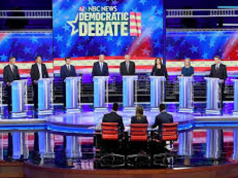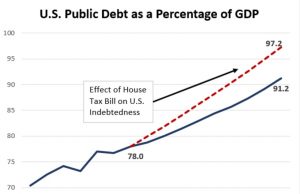A recent survey of the most hated professions found that although politicians were slightly more popular than debt collectors and telemarketers, they were held in lower regard than virtually every other profession including car salesmen and the issuers of parking tickets. It seems that the explanation for the low standing of elected officials is the widely held perception that they don’t deliver on their promises.
My observation from years of politician watching is that the mismatch between campaign promises and performance is most often the result of candidates promising to do things in office that are beyond the powers of the office they are seeking. Take Trump’s wall. As a candidate he promised that Mexico would pay for a wall. After Mexico told President Trump they would not, he said he would build it with U.S. tax dollars. Who knew about that tricky little sentence in the Constitution that blocks the President taking money from the Treasury unless Congress approves?
Trump, however, is only one of many candidates for the presidency who has made that mistake. The current legion of Democratic presidential hopefuls is replete with examples. More than a few have hope to take to capture their party nomination by convincing primary voters that whey will reshape America with the bold initiatives that they will issue from the Oval Office.
But virtually all of those initiatives require legislation which is to say the votes of 218 members of the House of Representatives as well as 60 United States Senators. The problem is that there are only about 175 Congressional Districts and perhaps 16 states that can reliably be expected to elect representatives that will support even the most popular of these initiatives. The other 43 votes needed in the House and 28 votes needed in the Senate will materialize only if their party wages intense and effective campaigns in decidedly conservative portions of the country.
Take the Senate for instance. To obtain the 60 votes necessary for cloture, the procedural step necessary to get legislation to the Senate Floor, these would be national leaders would either need a significant number of Republican votes or would have to help their party win a whole lot of seats in red states.
Because the Constitution gives each state the same number of Senators residents in small states have a much bigger say in the makeup of the upper body than voters in big states. In 2018, the number of votes needed to win a Senate seat in California was 56 times greater than the number needed to win a seat in Wyoming. By and large, smaller states have grown more conservative in recent decades and that is why Donald Trump won 30 of the 50 states in 2016 even though he lost the popular vote. As a result a Senate that would bring an agenda to the floor without Republican votes would require Democrats to win at least a third (20) of the seats necessary for cloture from states that voted for Trump.
It is easy to see how the Democrats could (in a good year) win the 4 seats they now need to gain the majority in the Senate but winning the 9 additional seats needed to allow these bold initiatives to be debated and adopted in the Senate would require a significant number of victorious Democratic campaigns in some very conservative portions of the country.
The situation in the House is less problematic for bold agenda items. They now hold 235 of the 435 seats, 17 more than needed for control or passage of specific programs. But preserving the current Democratic majority in the House in 2020 and beyond can not be taken for granted.
House members are usually targeted by the opposing party if they win with less than 55 percent of the vote. Last November, 35 of the Democrats that were elected fell below that number and 21 were elected by margins of less than 5 percentage points. More than 50 House Democrats now hold seats that were held by Republicans at some point in the last 5 years. The balance of power in the House and its ability to move a presidential agenda rests solidly in the hands of voters in moderate to conservative districts.
The current Democratic Majority is the result of extraordinary efforts by people. Kendra Horn is the first Democrat to be elected from any Congressional District in Oklahoma in 8 years. Lucy McBath now represents the district in Georgia once held by former Speaker Newt Gingrich and more recently by Tom Price, Donald Trump’s ultra-right appointee to run the Department of Health and Human Services. Joe Cunningham last fall became the first Democrat to carry the 1st District of South Carolina in 40 years and Abagail Spanberger won a Congressional District in Central Virginia that Mitt Romney carried against Barrack Obama by 15 points.
Other Democrats who make the Democratic majority possible are Ben Adams in Utah; Lauren Underwood and Sean Casten who have formerly Republican Districts in Illinois; Max Rose who now represents the Republican strong hold of Staten Island and Colin Allred and Lizzie Fletcher who battled to victory in very tough portions of Texas. And these are only a few of the Democrats who hold districts where Fox News is a dominant source of information and where many of the bold ideas that have appeal in some parts of the country are about as welcome as the Measles.
In the end, what we can or cannot accomplish in the coming years will be heavily dependent on the courage and survival of people like these. Any candidate for the presidency who really cares about policies that will improve the opportunities of Americans other than themselves, will want an agenda that can be sold in districts like the ones these people represent—otherwise that agenda will be nothing more than yet another set of broken promises–only adding to the nation’s cynicism and disdain for political leaders.
The truth is, if you attempted to place all 24 Democratic presidential candidates and their proposals on a spectrum ranging from the most conservative to the most liberal, you would see great similarities on the vast majority of issues facing the country. You would also find that regardless of what they are promising in their campaign speeches none to them will be able to deliver any more than the Congress will enact and ironically, those most skilled at talking to and persuading conservative voters will almost certainly be the one most likely to deliver on a progressive agenda.
I don’t make these observations as someone trying to push the party and its policies to the right. I have a long list of changes I would like to see in our nation’s social, environmental and economic policies. The list of investments I think the government should be making in human capital, scientific research and infrastructure is even longer. But I have learned through the years that virtually none of that will happen unless you can convince a great many moderates and at least a few conservatives that these policies would be good. In short, I find the candidates that are promising the most are often the ones that will deliver the least.
But beyond searching for policies that will take us to a better and high level there is, unfortunately, a more pressing consideration in this election. Failure to include moderates and reasonable conservatives in our discussions and invite them into our coalition will not compromise and perhaps destroy our chances of advancing sensible new approaches to creating a more humane and equitable society, it could easily mean the reelection of the worst President in American history and thus putting our society itself at serious risk.











